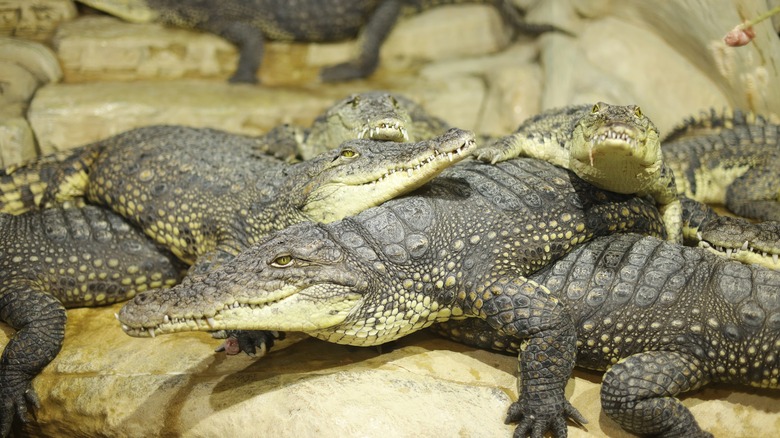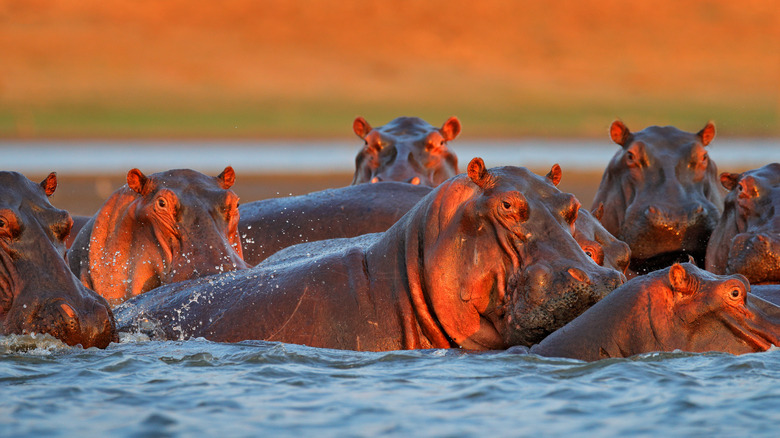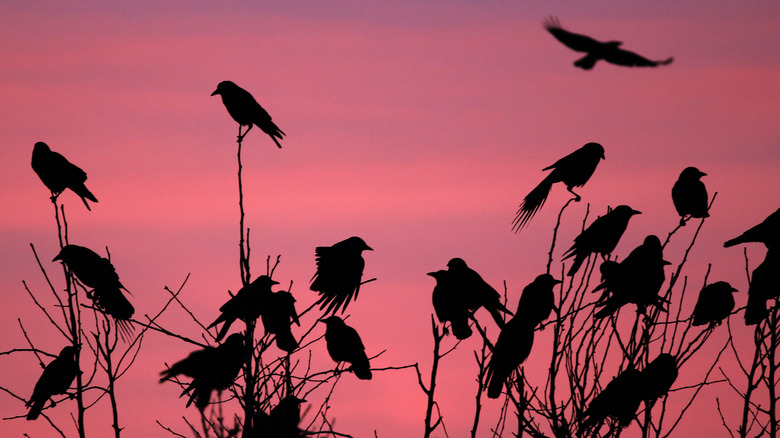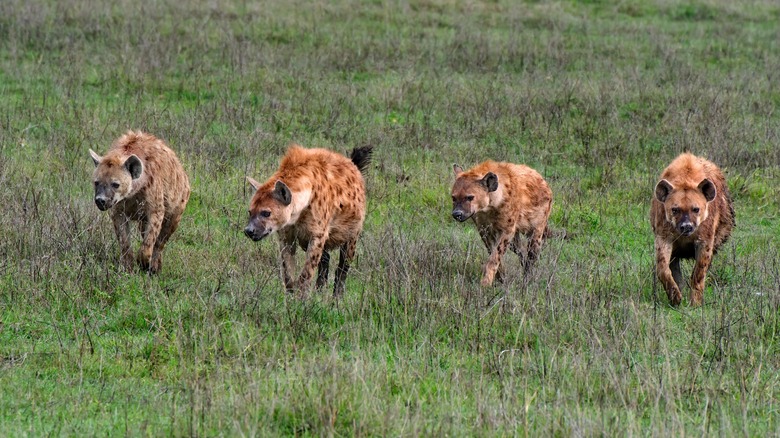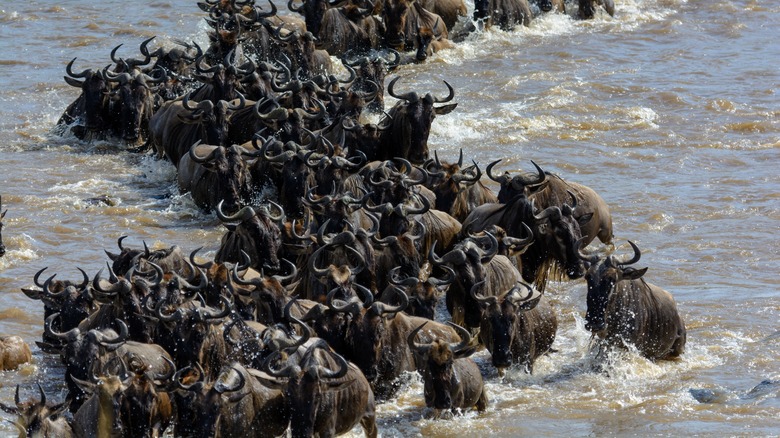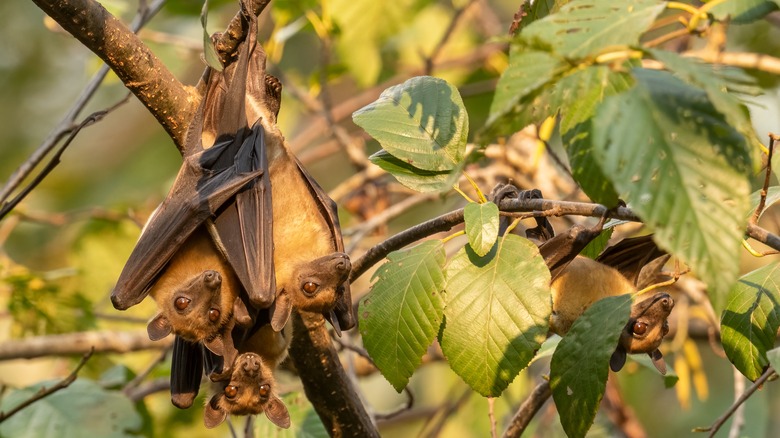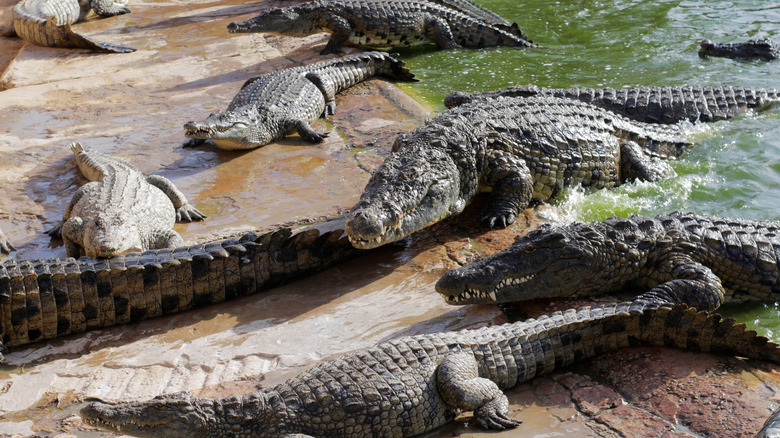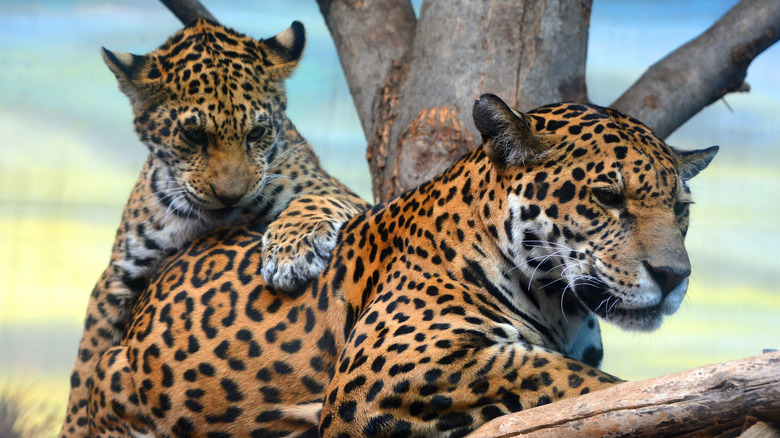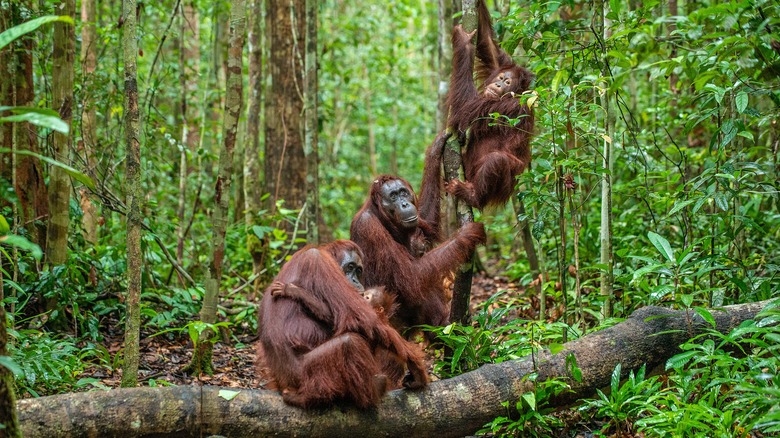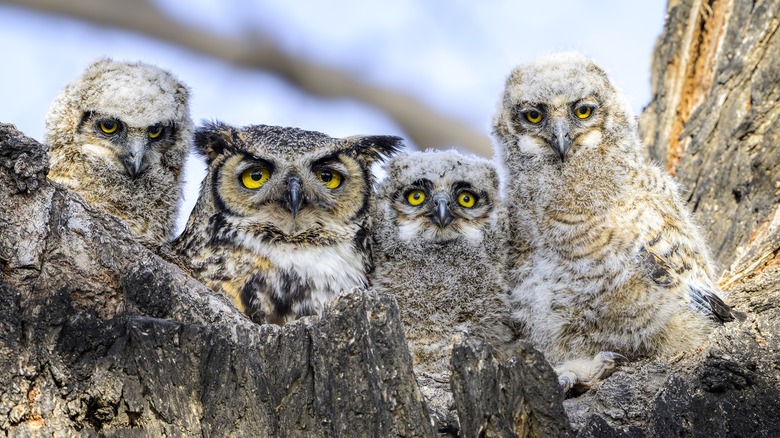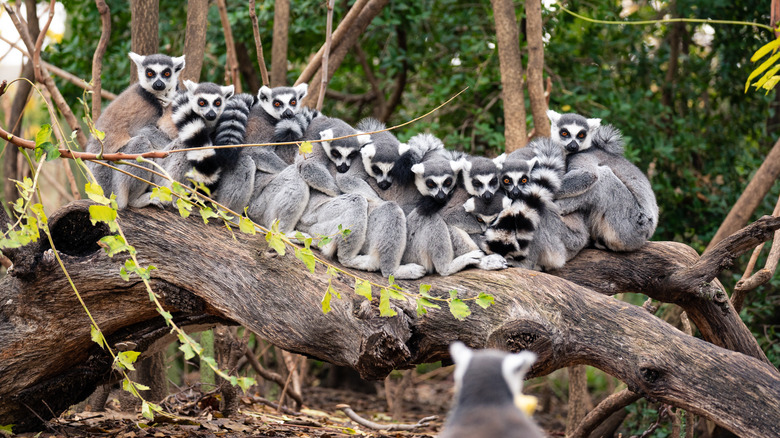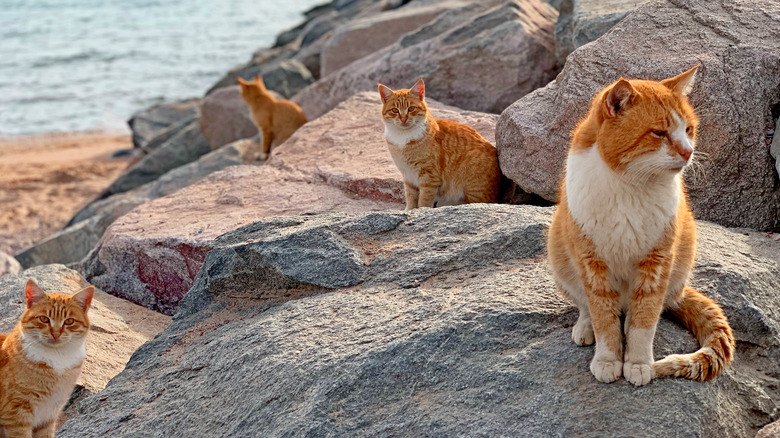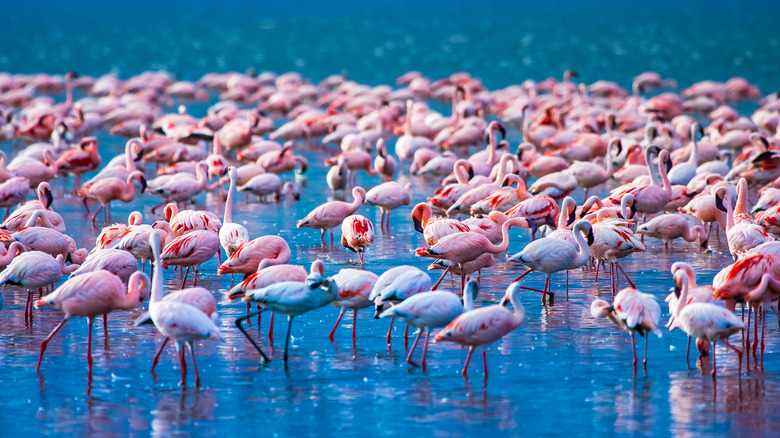The Oddest Animal Group Names Explained
Any group of animals, human or nonhuman, has a name, also known as a collective known (via Collins Dictionary). Packs of wolves, flocks of birds, and herds of cows rarely surprised anyone. But when Dame Juliana Berners of Sopwell wrote about an "unkindnes [sic] of ravens," her book ended up in a museum. As St Albans Museum mentions, The Book of St Albans was written as early as 1486, and it contains several group names, some of which still define various groups of animals today. Of course, "a congregation of people" isn't used that often nowadays — much less "a superfluity of nuns" — but Berners laid the grounds for the strange and whimsical world of group names.
Some animal group names are all too obvious — take "a tower of giraffes" or "a business of mongoose," for example. As BBC Travel writer Kerry Medina notes, it's easy to see how the tallest mammals on Earth or the always-busy families of mongoose got their group names. But this doesn't make the hilarious group names any less enchanting. Let's explore the not-so-obvious group names and the animals behind them.
A bloat of hippos
If you ever saw a hippo outside its beloved murky waters, you'd probably understand why the group name for several hippos is called "a bloat." As Discover Wildlife reports, hippos are only second in size to elephants when it comes to land animals. Male hippos weigh anywhere between 3,500 – 7,000 pounds with females weighing considerably less: 1,400 – 5,200 pounds.
But that's not all. Hippos' bellies are famously round, hence the "bloat" — as per BBC Travel, the name is pretty self-explanatory when you see the bulky animals up close. But don't let their bellies fool you — hippos are very fast in the water, where they run on the bottom of the river rather than swim, as pr Discover Wildlife. They are the deadliest and most territorial land mammal, with some 500 people falling victim to hippo attacks every year in Africa. Their mating fights are also famously violent, as per BBC Earth. The fights get even worse during the drought season, when the rivers are smaller and several male hippos are forced to share the space (and the bloat). So if you see a hippo, you better not rush to study it up close. And if you see a bloat of round-bellied hippos, definitely keep a safe distance.
A murder of crows
Back in the 1400s, "murder" didn't have the exact same meaning as today. According to Merriam-Webster, 15th-century England saw a rise in popularity when it came to hunting terms and group names for game animals. Lists of hunting terms and animal group names accompanied a myriad of writings in the 1400s, and several of these contained "a murder of crows." While it's unclear how exactly "murder" became the group name for the intelligent birds, the collective noun somehow stuck with people for more than half a millennium.
Among the strongest theories relating to the group name's etymology is the crows' centuries-long association with death. As per PBS, this is in part thanks to their black feathers, intelligence, and very large and loud gatherings. They might have seemed to be plotting something dark, or perhaps they were simply terrible pests to farmers, "murdering" their crops over and over again. Nevertheless, this is nothing more than an association based on an old fear.
Crows are highly social creatures: According to the Nature Conservancy, they help their parents by bringing food for their younger siblings, and, as per a study highlighted in Live Science, they even hold funerals for those in their families, in an attempt to understand the threat and remove or avoid it in the future. They also mate for life and can speak around 250 "words" or calls (via PBS). So if you see a big murder of crows, they're most likely not plotting murder but staying together to protect themselves from larger predators, like hawks and owls.
A cackle of hyenas
If you saw "The Lion King," you probably still have the sound of the hyenas' mean laughter in your ears. They would torment every animal they could get their hands on, and they would have a hysterical laugh about it later. But according to National Geographic, real-world hyenas' laughter is pretty far from a human one. Hyenas' giggles are a sign of distress or frustration, usually heard if a member of the family is being harassed or attacked.
Hyenas also rumble to let their families know about incoming dangers, and squitter to ask their mothers for milk. A whoop from a hyena is a way of introduction, calling out age and gender. And as Britannica confirms, the pitch of these whoops is what indicates those specifics. Hyenas' notorious giggles thus work as calls, introductions, signs of stress and frustration, and even deterrents for other predators, like cheetahs.
It's safe to say that hyenas are amongst the most talkative animals — and arguably, the chattiest mammals — on Earth. This is what earned them the "cackle of hyenas" group name. A cackle is nothing more than harsh laughter, and to the non-hyena ear, this is what hyenas sound like.
A confusion of wildebeest
The answer to this fairly confusing group name lies in wildebeest's behavior. As per Expert Africa, every year, wildebeest migrate in the millions across Africa, sometimes alongside zebra, gazelles, and impalas. The impressive migration is triggered by the end of the rainy season, every year in May or June, as National Geographic reports. But even though wildebeest do this every year, the migration can prove to be a terrifying and very confusing experience.
Wildebeest follow each other blindly across the African savanna, through territories filled with lions, crocodiles, and other large predators who would happily eat the passing antelopes. Moreover, approximately 6,500 wildebeest drown every year while crossing the Mara River, as shown by Science Magazine. They either become blocked at the exit, if the bank is too steep, or trample each other in the water, as they rush to the other side. The silver lining is that the many carcasses then feed crocodiles, vultures, fish, and any other animal living around the central African rivers.
It's thus easy to see how wildebeest got their group name. Watching their great migration is certainly confusing, and it's not hard to imagine just how confused they feel from June to November, each year.
A cauldron of bats
The Atlantic writer Rebecca Giggs describes a ghost bat killing a budgerigar (parakeet) and sucking the blood from its neck to reveal why humans have had an ancestral fear of bats. Of course, there are also the, arguably, much cuter fruit bats (or megabats), who look more like flying dogs than vampires or demons. But since all bats are active at night, sleep upside down in clusters, and make shrieking noises, it's easy to see how, for a long time, people have associated them with the dark side of life. In Medieval times, this was witchcraft.
Bat Conservation International confirms, witches and bats (and witches' cauldrons) have been associated for a long time. William Shakespeare's "Macbeth" song, "Double, double toil and trouble," stands as proof: "Double, double toil and trouble/Fire burn and caldron bubble ... Eye of newt and toe of frog/Wool of bat and tongue of dog."
As per Sycamore Land Trust, the 19th century shifted bats' association from witches to vampires, as a result of Bram Stoker's 1897 "Dracula" showing vampires shapeshifting into bats. Nowadays, this connection is kept alive by Halloween costumes and decorations. And since Halloween is also the time for wizards and witches, sometimes bats are still shown by their side. Bats' group name — "a cauldron of bats" — is thus a perfect rendition of their centuries-long association with witchcraft (an association which, as per Issues, has harmed bats more than anything).
A bask/float of crocodiles
While perhaps self-explanatory, crocodiles' group name is made interesting by how it changes depending on where the group is. As per Gareth Stevens' book, "A Float of Crocodiles," a group of crocodiles is only called a float if they are in the water, famously floating with only their eyes and snouts over the surface. However, if the group of crocodiles is on land, they are called a bask — this is because, like all reptiles, crocodiles bask in the sun to regulate their body temperature, according to Smithsonian's National Zoo.
What's even more interesting is that crocodiles live in huge groups and, sometimes, the group is literally divided between a float and a bask. As AZ Animals confirms, crocodiles take turns: Some of them hunt in the water while others rest (and bask in the sun). Others are even assigned babysitter roles, keeping their eggs and babies safe from predators and other crocodiles, while the rest of the family is busy hunting. Funnily enough, alligators behave similarly, but a group of alligators is called a "congregation" — yet another example of the slightly chaotic world of animal group names.
A shadow of jaguars
It's the jaguar's elusiveness (sometimes even called "invisibility") that has had the Indigenous people of Peru revere its spirit, according to National Geographic. The jaguar is an apex predator as well as a very mysterious animal. As Mongabay reports, the jaguar is a stalk-and-ambush predator — this means that it hunts in the shadows, stalking its prey (anteaters, capybara, tapirs, or deer) until it's ready to ambush it and take its life.
Things get even more elusive when it comes to the rare black jaguar, which, as per the World Wildlife Fund, is not all black but sports the same jaguar "rosettes" under darker fur. Jaguars are incredibly difficult to spot in the wild, hence their group name. Sadly, they're hard to find also because their population has been in a steep decline for quite some time, mainly thanks to poaching and deforestation. With half their territory gone since the 1880s, they are now classified as "Near Threatened," and WWF is currently working to protect the species and expand its habitat once more.
There's another reason it's highly unlikely you'll see "a shadow of jaguars": They're solitary creatures. So, unless it's a mother and her cub, most jaguars live and hunt alone ... from the shadows.
A shrewdness of apes
As per Merriam-Webster, shrewd means "marked by clever discerning awareness and hardheaded acumen." Which group of animals is more fit to be named a "shrewdness" than apes then? According to National Geographic, apes are incredibly intelligent: Koko the lowland gorilla could use over a thousand signs to communicate with humans and understood around 2,000 English words. Kanzi the bonobo demonstrated that his species can learn the English language by simply being exposed to it, just like human children. Ayumu the chimpanzee beat humans in a short-term memory computer game. Azy the orangutan makes perfect correlations between real-world objects and their icons on computer screens, understanding perspective to make logical choices.
Orangutans can do something even more impressive: As per Smithsonian Magazine, they can reference events from their past. Researcher Adriano Reis e Lameira explained (via University of St. Andrews), "The vocal behavior is not simply a reflex or conditioned response towards danger but a measured and controlled behavior." These are only fragments of what scientists have discovered so far about ape intelligence. The greater part of their inner world is still hidden from human researchers, so it's safe to say apes are truly shrewd and have fully earned their group name.
A parliament of owls
In C.S. Lewis' fantasy novel series "The Chronicles of Narnia," there is an organization of owls meeting at night that discusses the various happenings in their world. They form a "parliament of owls" — of course, what better species to form a parliament than the wise owl? But what makes an owl wise? According to BBC Wildilfe Magazine, humans first started associating owls with wisdom in ancient Greece, when owls stood as symbol for Athena, the goddess of wisdom and reason. The owl as a symbol of wisdom continued to show up in modern architecture as well, as shown by the University of Texas, albeit not as frequently.
There are so many depictions of wise and/or knowledgeable owls in pop culture and literature — from Winnie the Pooh to Lewis' novels — that it's hard to see them otherwise. However, as BBC Wildlife Magazine notes, Lewis didn't just choose owls to make up his parliament because of their association with wisdom. It's also a play on words from Chaucer's poem, "A Parliament of Fowls," where all birds come together to find a mate. "The Chronicles of Narnia" ended up being a worldwide success, making "a parliament of owls" officially recognized as the group name for owls.
A conspiracy of lemurs
As National Geographic reports, lemurs live in large troops -– or conspiracies, according to the Oregon Zoo –- of up to 30 individuals. Not only do they form strong bonds with each other, but they communicate constantly, strengthening their relationships and making sure no predator outwits their gang. They have several techniques to do so: One of them is called mobbing, as per Folia Primatologica. Lemurs mob against their predators by harassing them as a team. They call out and let each other know where the predator is, then they approach and attack it, driving it away. Cooperation is key here -– it's easy to see how one lone lemur couldn't defend itself from a predator, let alone call off a surprise attack just by yelling at it.
As per a 2015 study in Folia Primatologica, lemurs often talk to one another — if one calls out about imminent danger, the others respond in various ways. This shows just how united the Madagascar primates are. It's unclear where the origins of "a conspiracy of lemurs" lie, but it's clear how lemurs congregating in the dozens and chatting to one another while looking out for predators might look like a conspiracy.
A destruction of cats
"A destruction of cats" might just be the strangest animal group name yet, especially considering how big a role cats play in our lives, and how no one ever refers to their beloved pets as "a destruction." But as AZ Animals reports, "destruction" is only used to name a group of wild/feral cats — that is, a cat without a home or positive human interaction. A 2013 study in Nature Communications makes clear why this should be the group name for feral cats: On average, cats kill 1.3 – 4 billion birds and 6.3 – 22.3 billion mammals every year, just in the United States. The grand majority of the killings are done by stray cats, making them by far one of the most destructive species on Earth.
But CARMA paints a slightly grimmer picture: It's not just feral cats that destroy the environment but humans who destroy cats' lives when they fail to spay or neuter their cats, or when they abandon their unwanted pets, letting them form feral colonies that quickly spiral out of control. Nevertheless, feral or not, cats will hunt a lot (and as per Ecosphere, pet cats hunt for fun, even when they have more than enough food at home). "A destruction of cats" is therefore as fitting a name as it is a reminder to care for — and neuter — our beloved companions.
A flamboyance of flamingos
A flamboyant person attracts all the eyes in a room through their confidence and (perhaps flashy) style. Who would win the flamboyance price in the animal kingdom then? Bar the dazzling peacock, perhaps only the flamingo is worthy. As The Atlantic shows, everything about the flamingos, from their elegant postures and walk to their large, calm gatherings and amazing colors, screams "flamboyant."
But as Live Science suggests, flamingos earn not only their group name but their coloring, too. Flamingos are actually born gray, but the high content of beta-carotene found in the algae and crustaceans (shrimp and mollusks) they eat slowly turns their feathers bright pink. The color varies from pale pink to crimson, depending on the level of beta-carotene found in the local food.
Of course, not all birds (let alone other animals) can change their color through their diet. Flamingos' special digestive system processes the food pigment into fat, which is then deposited in their feathers. This pigmented fat is what makes flamingos pink, so they truly are what they eat. Flamingos earn their beautiful group name through a consistently healthy diet.
